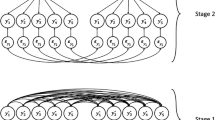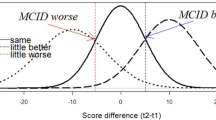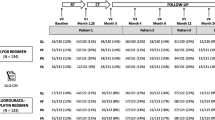Abstract
Purpose
Missing data due to attrition present a challenge for the assessment and interpretation of change and response shift in HRQL outcomes. The objective was to handle such missingness and to assess response shift and ‘true change’ with the use of an attrition-based multigroup structural equation modeling (SEM) approach.
Method
Functional limitations and health impairments were measured in 1,157 cancer patients, who were treated with palliative radiotherapy for painful bone metastases, before [time (T) 0], every week after treatment (T1 through T12), and then monthly for up to 2 years (T13 through T24). To handle missing data due to attrition, the SEM procedure was extended to a multigroup approach, in which we distinguished three groups: short survival (3–5 measurements), medium survival (6–12 measurements), and long survival (>12 measurements).
Results
Attrition after third, sixth, and 13th measurement occasions was 11, 24, and 41 %, respectively. Results show that patterns of change in functional limitations and health impairments differ between patients with short, medium, or long survival. Moreover, three response-shift effects were detected: recalibration of ‘pain’ and ‘sickness’ and reprioritization of ‘physical functioning.’ If response-shift effects would not have been taken into account, functional limitations and health impairments would generally be underestimated across measurements.
Conclusions
The multigroup SEM approach enables the analysis of data from patients with different patterns of missing data due to attrition. This approach does not only allow for detection of response shift and assessment of true change across measurements, but also allow for detection of differences in response shift and true change across groups of patients with different attrition rates.



Similar content being viewed by others
References
Sprangers, M. A. G., Moinpour, C. M., Moynihan, T., Patrick, D. L., Revicki, D. A., & The Clinical Significance Consensus Meeting Group. (2002). Assessing meaningful change in quality of life over time: A users’ guide for clinicians. Mayo Clinic Proceedings, 77, 561–571.
Sprangers, M. A. G., & Schwartz, C. E. (1999). Integrating response shift into health-related quality of life research: A theoretical model. Social Science and Medicine, 48, 1507–1515.
Oort, F. J. (2005). Using structural equation modeling to detect response shifts and true change. Quality of Life Research, 14, 587–598.
Steenland, E., Leer, J., van Houwelingen, H., Post, W. J., van den Hout, W. B., Kievit, J., et al. (1999). The effect of a single fraction compared to multiple fractions on painful bone metastases: A global analysis of the Dutch Bone Metastasis Study. Radiotherapy and Oncology, 52, 101–109.
Van der Linden, Y. M., Lok, J. J., Steenland, E., Martijn, H., van Houwelingen, H., Marijnen, C. A. M., et al. (2004). Single fraction radiotherapy is efficacious: A further analysis of the Dutch bone metastasis study controlling for the influence of retreatment. International Journal of Radiation Oncology Biology Physics, 59, 528–537.
De Haes, J. C. J. M., Olschewski, M., Fayers P., Visser, M. R. M., Cull, A., Hopwood, P., & Sanderman, R. (1996). Measuring the quality of life of cancer patients with the Rotterdam Symptom Checklist (RSCL): A manual. The Netherlands: Northern Centre for Healthcare Research (NCH), University of Groningen.
The EuroQol Group. (1990). EuroQol: A new facility for the measurement of health-related quality of life. Health Policy, 16, 199–206.
Aaronson, N. K., Ahmedzai, S., Bergman, B., Bullinger, M., Cull, A., Duez, N. J., et al. (1993). The European organization for research and treatment of cancer QLQ-C30: A quality-of-life instrument for use in international clinical trials in oncology. Journal of the National Cancer Institute, 85, 365–376.
Cronbach, L. J. (1951). Coefficient alpha and the internal structure of tests. Psychometrika, 16, 297–334.
Dempster, A. P., Laird, N. M., & Rubin, D. B. (1977). Maximum likelihood from incomplete data via the EM algorithm. Journal of the Royal Statistical Society (Series B), 39, 1–38.
Oort, F. J. (2001). Three-mode models for multivariate longitudinal data. British Journal of Mathematical and Statistical Psychology, 54, 49–78.
Verdam, M. G. E., Oort, F. J., van der Linden, Y. M., & Sprangers, M. A. G. (2013). The analysis of multivariate longitudinal data: An application of the longitudinal three-mode model in health-related quality of life data. Paper presented at the annual meeting of the Working Group Structural Equation Modeling, Bielefeld, Germany.
Boker, S., Neale, M., Maes, H., Wilde, M., Spiegel, M., Brick, T., et al. (2011). Openmx: An open source extended structural equation modeling framework. Psychometrika, 76, 306–317.
Steiger, J. H., & Lind, J. C. (1980). Statistically based tests for the number of common factors. Paper presented at the annual meeting of the Psychometric Society, Iowa City, IA.
Steiger, J. H. (1990). Structural model evaluation and modification: An interval estimation approach. Multivariate Behavioral Research, 25, 173–180.
Browne, M. W., & Cudeck, R. (1992). Alternative ways of assessing model fit. Sociological Methods Research, 21, 230–258.
Browne, M. W., & Cudeck, R. (1989). Single sample cross-validation indices for covariance structures. Multivariate Behavioral Research, 24, 445–455.
Dudgeon, P. (2003). NIESEM: A computer program for calculating noncentral interval estimates (and power analysis) for structural equation modeling. Melbourne: University of Melbourne, Department of Psychology.
World Health Organization. (2002). Towards a common language for functioning, disability and health: The international classification of functioning, disability and health (ICF). Geneva: World Health Organization.
Acknowledgments
This work was supported by a grant from the Dutch Cancer Society (Project Number: UVA 2011-4985). M. G. E. Verdam and F. J. Oort participate in the Research Priority Area Yield of the University of Amsterdam.
Author information
Authors and Affiliations
Corresponding author
Rights and permissions
About this article
Cite this article
Verdam, M.G.E., Oort, F.J., van der Linden, Y.M. et al. Taking into account the impact of attrition on the assessment of response shift and true change: a multigroup structural equation modeling approach. Qual Life Res 24, 541–551 (2015). https://doi.org/10.1007/s11136-014-0829-y
Accepted:
Published:
Issue Date:
DOI: https://doi.org/10.1007/s11136-014-0829-y




